Bull Terriers, the iconic eggheads are among the favorite celebrity dog breeds, but if you wanted to get one, you’ll definitely need a Bull Terrier growth chart in order to help you learn how to better take care of them.
A Bull Terrier growth chart is a helpful reference guide to how big your dog should be weight and height wise at a specific age, helping you better coordinate feeding times among other things.
Do keep in mind that these are all estimates, average ranges taken from a variety of different dogs so the numbers may be a bit skewed for your dog since every dog is unique after all.
The best results will always come from mixing what the growth chart shows you with what your vet tells you is good for your canine companion as well as trial and error with his diet which you’ll get the hang of over time.
The most hectic period for dogs tends to be their puppy life stage as they’re still growing, but once they reach adulthood, it tends to simmer down a little and stagnate, making your job a lot easier.
Though you will have to keep your dog in shape still throughout his life which involves not just feeding, but exercise and other lifestyle choices.
To find out what affects his growth and what these charts look like over the course of his life as well as find answers to some of the most commonly asked questions about his growth and health, be sure to read on.
The Bull Terrier Growth Chart
| Age | Weight (kg) | Weight (lbs) |
|---|---|---|
| 3 Months | 8 – 14.3 kg | 17.6 – 31.5 lbs |
| 4 Months | 10.8 – 19 kg | 23.8 – 41.9 lbs |
| 5 Months | 13 – 23.1 kg | 28.6 – 51 lbs |
| 6 Months | 14.7 – 26.7 kg | 32.5 – 58.9 lbs |
| 7 Months | 16.5 – 30 kg | 36.3 – 66.1 lbs |
| 8 Months | 17.8 – 32.5 kg | 29.2 – 71.6 lbs |
| 9 Months | 18.4 – 34.2 kg | 40.5 – 75.4 lbs |
| 10 Months | 18.7 – 35.8 kg | 41.2 – 78.9 lbs |
| 11 Months | 19.1 – 37 kg | 42.1 – 81.5 lbs |
| 12 Months | 19.4 – 37.8 kg | 42.8 – 83.2 lbs |
As you can see on this Bull Terrier size chart, he undergoes a relatively normal growth process with the biggest growth spurts occurring around the 2-5 month period, after which it starts to gradually slow down.
Once he reaches his 9 month threshold is where it really starts to slow down and reaches its peak the closer he nears his first birthday.
After the Bull Terrier puppy enters adulthood, you’ll need to exchange the puppy food out for adult food, and yes, there is a difference between the two.
Other than that, it’ll be mostly maintenance in terms of exercise and healthy dieting on top of other duties that may pop up like visits to the vet and the like.
As he grows older, he’ll need to eat less as his metabolism starts slowing down.
When he hits year 10-11, he’ll officially be transitioning over to his senior years which may require moving over to food better suited for older dogs, softer and easier to digest.
As for how it all goes throughout his entire life, here’s a slightly more detailed description of your duties and the duties of the breeder from birth to old age that the Bull Terrier weight chart can’t relay through numbers alone.
Bull Terrier Growth Throughout The Years
0-2 Weeks Of Age


The initial start of our beloved egghead is the same as any other dog, given birth to a loving mother who’ll be taking care of his needs as well as the needs of his siblings from the same litter.
This is the period where the breeder only takes care of the mother and makes sure she’s fed while she feeds the young ones.
The only time where he’ll have to step in in her stead is if one or more of the pups end up being rejected by the mother, either by being exposed to too much contact from humans or for other reasons.
Whatever the reason may be though, you’ll need to prepare a heating pad and a milk replacement option, lay the pup on the pad and feed him through a bottle.
This helps emulate the feeling of his mother’s embrace making him more likely to accept the food and not suffer any complications during his further growth.
Some breeders take a few extra steps by covering the pad in a fabric with a texture similar to that of the mother’s fur and even utilize a ticking clock placed under the pad to imitate the mother’s heartbeat.
While welcome, these steps are completely optional.
3-4 Weeks Of Age
Your little Bully Terrier will still technically be in his infancy, but he would’ve grown up enough to be able to wander around on his own, though he still won’t go too far away from his mom.
While most of them will still be on the diet of mother’s milk, some of the more advanced ones are more likely to wean off it now and move over to puppy kibble.
It’s a good time to start trying to do so and see which one of them takes to it.
While success rates are high, you’re likely to be left with a few stragglers, but attempting it again every few days until they do will get them eventually.
To better increase your chances of it succeeding, mix in 3 parts water and 1 part kibble at the start to soften it up and to make the texture something more familiar to the pups.
After that, slowly adjust the ratios with each meal until you no longer need the water in the first place.
This tricks the dogs into taking to the new food without having to risk them not swapping to it otherwise.
The period where the dogs have grown several inches tall and are autonomously exploring their surroundings without the aid of their mother.
5-8 Weeks Of Age
Sure, there will still be some momma’s boys and girls, but they’re old and mature enough to be ready for rehoming at the end of this period.
It’s also a time where you’ll want to start getting them some behavioral training to build some discipline into them so they don’t cause too much trouble for their new owners.
And, of course, this is the final period in which they absolutely have to move on over to puppy dog food otherwise they’ll be having a real hard time consuming proper food once they’re fully separated from their mother.
3-4 Months Of Age
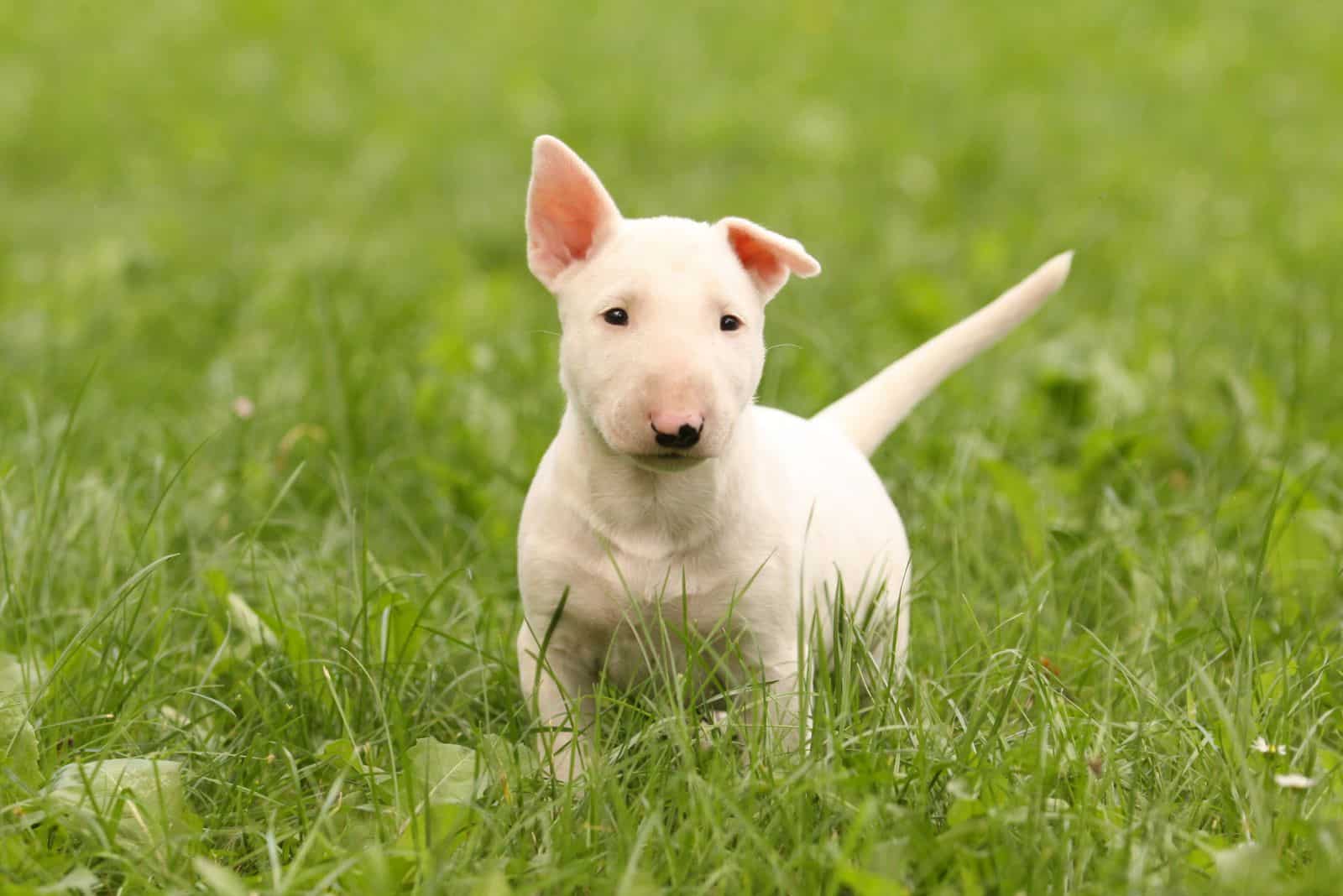

The standard period at which you as a dog owner would receive your new Bull Terrier puppy. He may still be a little cranky dealing with separation from his siblings and his mother, but he’ll get used to you soon enough.
What’s important is that you spend this time to bond with him so he feels more comfortable around you and that you continue with his behavioral training to get him in line.
Naturally, proper feeding is important as well to help bulk the doggy up so he can continue growing at a healthy pace.
5-9 Months Of Age
The final big growth spurt for the doggo before he reaches what should approximately be his adult weight and full size.
It’s by this time that he should also be finishing that behavioral training up, but don’t let the practice slip away.
The amount of food he should be consuming should slowly be going down by the tail end of it here as he’ll come into his adult size, though puppy food is still recommended for the time being.
Do be sure to have him get his daily exercise in to keep his figure. You don’t want him getting overweight, especially not at this young an age while he’s still developing.
10-12 Months Of Age
The small period before your dog’s first birthday is the recommended one for transitioning him over from puppy kibble to adult dog food, and you can use the same tricks that the breeders would use when swapping him from milk to puppy food.
It’s a pretty useful one and I guarantee you’ll be needing it in case you want to swap him over to a new brand of food for whatever reason.
Sometime during this period, if he hasn’t already, your dog would’ve finished his growth period both height and weight wise, at least in any larger bursts, and he can be considered a full adult.
1-10 Years Of Age (Adulthood)
As he moves onward to adulthood, you won’t really need to do too much to keep your dog in shape.
It’s all mostly maintenance now and you two can enjoy each other’s company without too much hassle aside from the odd medical emergency if one even happens.
Just make sure to do your best in keeping him healthy by keeping his shots up to date, keeping him on a healthy diet and getting him that exercise.
The closer he gets to his senior years, the slower his metabolism is going to get and the less active he’ll become due to lack of energy.
This also means that the feeding amount is going to dwindle as well as his portion sizes, but that should be solved as you go along and you adjust the amount of food according to his weight
10 Years And Onward (The Senior Life)
A Bull Terrier’s senior period may not be the longest lived, but those who do make it there still need care.
Daily exercise still plays an important part in their day to day lives as does the food which should be swapped out for one more appropriate for seniors if needed.
Most can still handle the adult stuff so you usually won’t have to hassle yourself with the swap tactic.
What Major Factors Impact A Dachshund’s Growth?
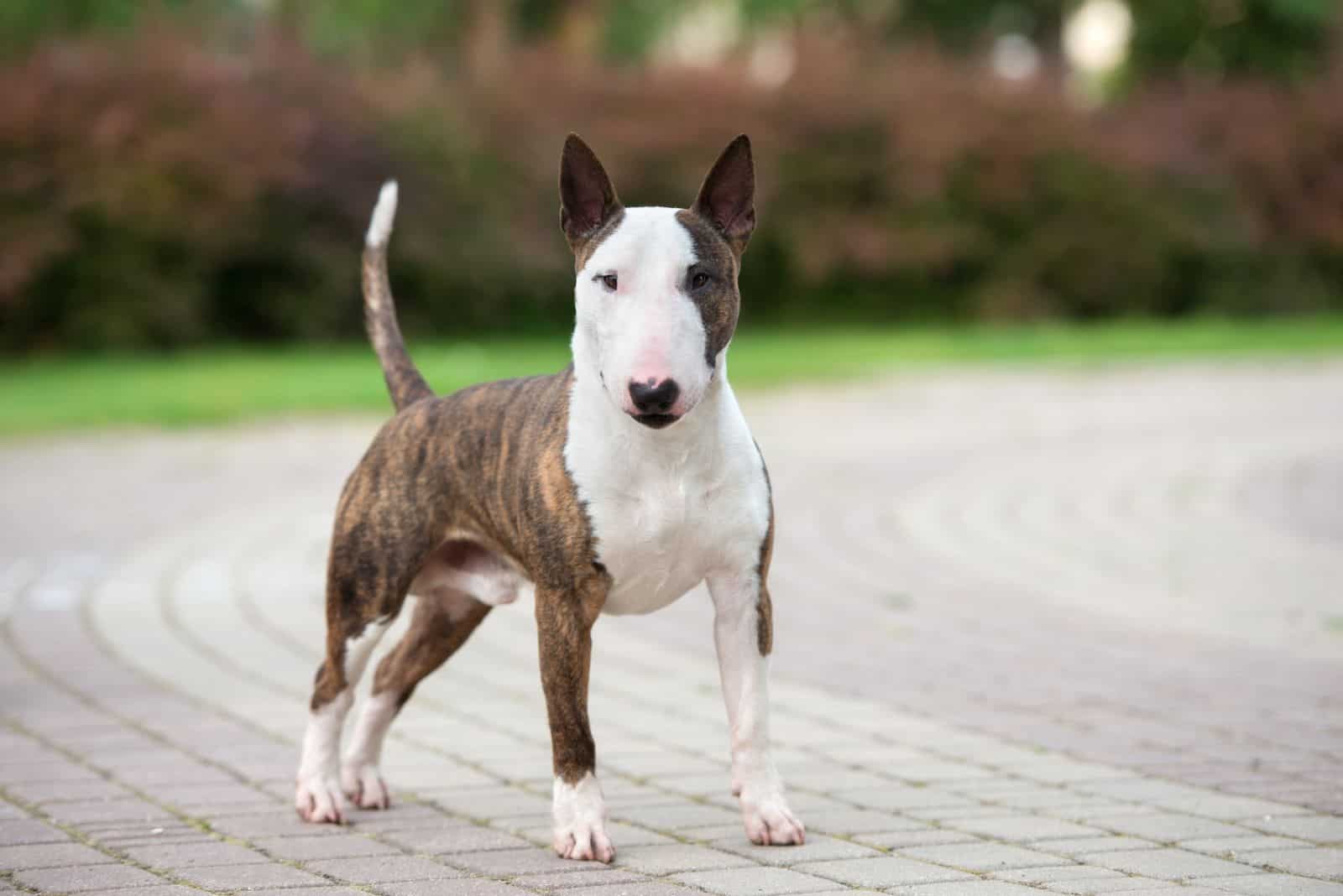

While the growth chart is a good assessment of an average Bull Terrier’s growth cycle, it’s not the definitive truth.
As a matter of fact, there are a number of factors that influence this, three very common ones which are present in every species, especially dogs.
Whether they impact it positively or negatively depends on their own quality, and this is what they are:
1. Genetics
Genes are in everything, at least in every living being, they’re the building blocks of many of our traits, be they physical or mental.
The same goes for dogs, from their behavior, their fur color, how prone they are to disease, and how much they’ll grow or how well their metabolism functions.
The latter three are the ones we’re looking for as they’re the key aspects that will tell how big or small the dog’s going to get and whether or not he’ll have an easy time putting on or losing some pounds should he get any.
The speed of the metabolism helps determine feeding amount and feeding habits as well as potential allergies which you’re likely to learn throughout the dog’s life, and, by default, avoid any potential issues.
On the other hand, being prone to certain diseases due to their genetic structure can sometimes have an impact on their growth too, especially if it affects bone or muscle structure.
However, the problem stems from the fact that genes can’t be messed with that easily and it’s simply the hand the dog’s dealt that he’ll have to manage for the rest of his life, and you’re there to help him.
This is especially true if it concerns some incurable disease that isn’t treated easily.
The only thing you can do is be attentive and spot if there’s something wrong with him, notice it early and hopefully prevent it before it turns into a more serious problem
2. What He Eats
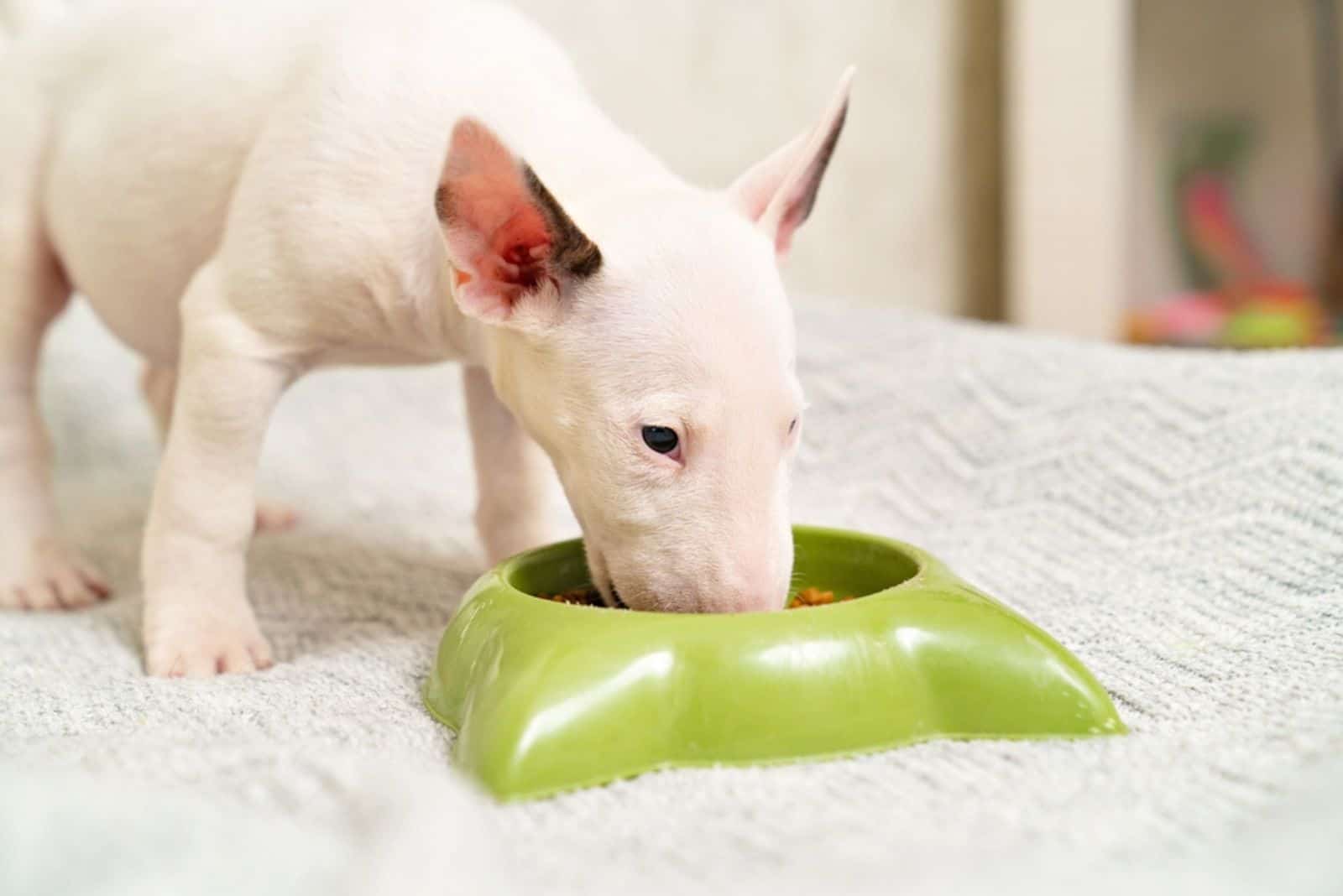

In order to grow, living beings need food, dogs too.
Your bully’s diet is responsible for his overall health and growth and is one of the most easily influenced factors of the three given here.
That’s because you can choose what he eats and can form a healthy plan for him together with your dog’s vet or pet nutritionist.
That said, it helps to know what you need to get him. Dry dog food is usually the best go-to with a mix of the other options, but what about the minerals and nutrients?
How will you know which of those are the best?
Well, don’t worry, I’ve got you covered there too.
Here are some of the major ones.
Quality Protein
A good and high-quality animal protein is the first ingredient of every piece of dog food, and chicken and beef tend to be the best ones to go for with the other alternatives being that of turkey, lamb or fish.
Fiber
Something to make all that protein go down smoother is always good to have paired with it, a source of fiber, be it rice, sweet potatoes, peas or similar.
A Healthy Protein To Fat Ratio
You’ll also want around a 30%-ish protein and 15%-ish fat ratio in his food ideally, though you can deviate on this one as long as the ratios remain relatively similar, but again, I’d advise consulting the vet on this one for more specific numbers.
Make sure to avoid fillers as they’re often just empty calories as well as some common allergens like corn, soy and wheat in your dog’s food if he’s having sensitivity issues.
Omega 3 Fatty Acids
Other than that, you’ll want to make sure that the food contains omega-3 and 6 fatty acids which help keep your dog’s fur nice and shiny and improve your dog’s overall immune system.
Probiotics
Speaking of which, a healthy batch of probiotics and prebiotic fiber is always welcome as it helps foster the growth of healthy gut bacteria which are responsible for digestion and a more responsive and healthier immune system.
Aside from that, you’ll want a healthy dose of vitamins in there, as per usual, to help with overall growth.
DHA and EPA
DHA and EPA are particularly important in puppies as they help develop and maintain their cognitive skills.
Calcium And Phosphorus
Calcium and phosphorus are important too as they help with proper bone and cartilage growth.
Glucosamine And Chondroitin
Aside from those, you also want to include some chondroitin and glucosamine which help maintain bone and joint health.
While not as important for smaller dogs as they are for medium and large dog breeds, they’re still nice to include to prevent general bone related health issues in your Bull Terrier’s senior years.
Do keep in mind that you don’t have to cover every single one of these nutrients even though they’re all useful.
Finding a type of food that has them all will be next to impossible, but the more you can clear, the better.
Also, the amount of food you feed him will vary depending on his metabolism, as said earlier. That one I can’t really relay to you properly, but simply watch his weight and remove or add food to his portions accordingly.
Be sure that he doesn’t end up getting too fat or too underfed as both extremes can cause a variety of different health issues which you’d rather your dog doesn’t have to deal with if you can avoid them.
And, of course, be wary of any potential allergic reactions that he may develop over the years for his own sake.
3. His Level Of Exercise
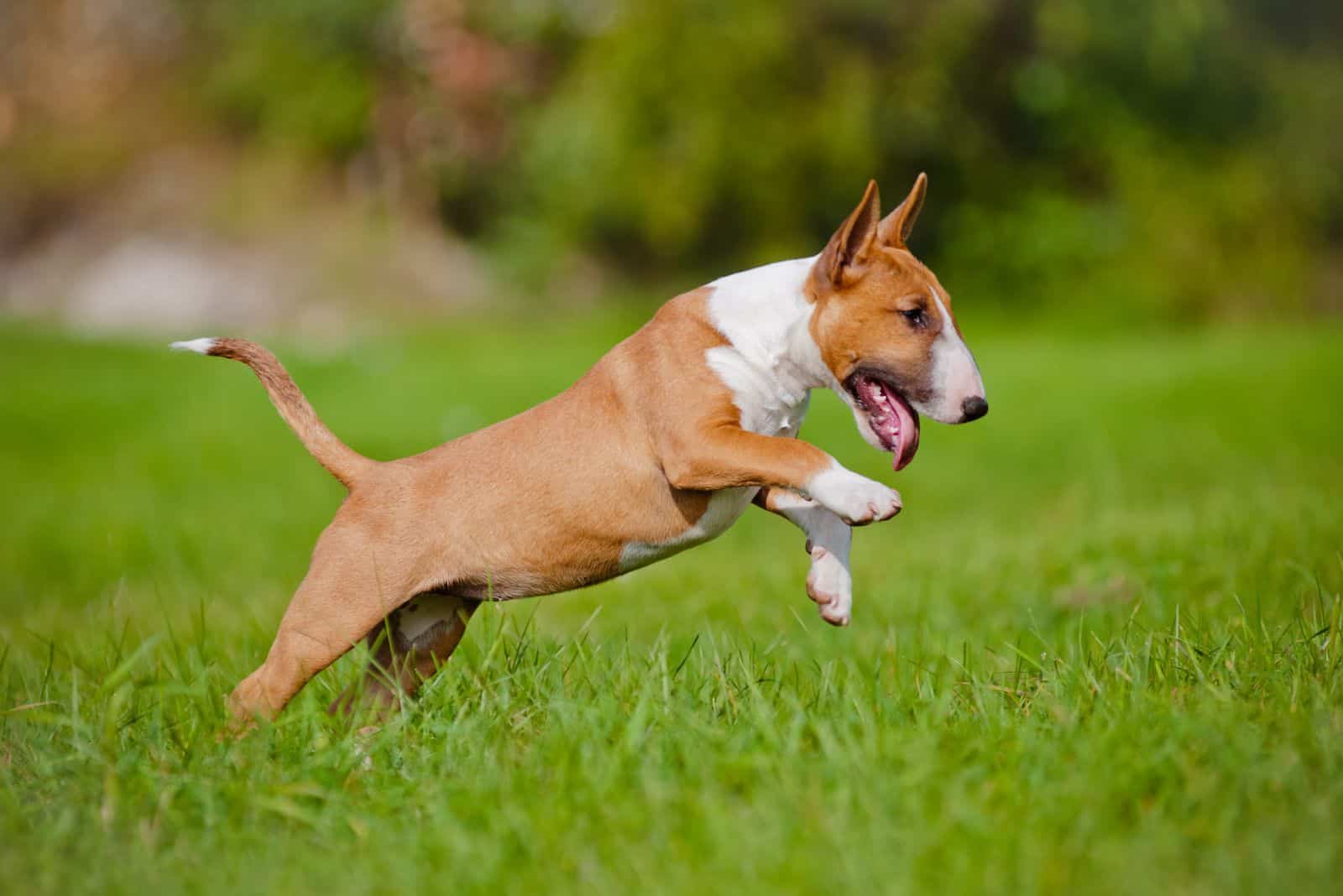

The Bull Terrier is meant to be a really active dog given their initial use as a dog fighting canine.
Though that dark past is behind him, his high levels of stamina still need to be maintained so he’ll need to get a proper workout in in order to keep his muscle tone and weight in check.
For Bully Terriers in particular, about an hour of moderate physical exercise that’s a mix of walks and play is recommended on top of some mental stimulation through puzzle toys or otherwise to keep their mind sharp and entertained.
It may sound like a lot of exercise, but that’s what the dog requires. And, believe me, time spent playing with him is going to practically fly by when you’re having fun with your furry best friend.
And be sure to take nice long walks, especially around areas he normally doesn’t frequent so he can get his other physical duties done and so he can explore new ground.
This way you’re not only helping him maintain his physical health, but mental health too by taking him for a more relaxing activity. It’ll even do you some good too, in both departments, albeit in different ways.
What Do Bull Terriers Look Like?
While there are a lot of dog breeds who belong to the Terrier Family, the Bull Terrier is a very unique member appearance wise, and not in a bad way.
He’s known for his egg-shaped head which is one of his most unique characteristics, paired together with a convex nose bridge to give him a more threatening appearance.
The pointed ears only further add to it, but this setup also makes the dog more aerodynamic, allowing him to be very speedy.
Their muscles are lean and accentuated with dogs sporting an impressive physique given the initial intent behind creating the breed in the first place.
This is all matched with their short coats which are predominantly white with the odd spot here and there depending on their parentage.
Despite having this imposing look to them, they’re quite lovable and enjoy hanging out with their owners.
It’s this unique mix that makes them a favorite among celebrities, at least in modern times on top of not being that high maintenance either aside from the exercise bit.
How Big Do Bull Terriers Get?
There are two different Bull Terrier sizes, the miniature Bull Terrier and the standard Bull Terrier.
We’re basing most of the dog’s weight and height off of the standard one, but I’ll cover both here.
The standard Bull Terrier reaches a height of around 21 inches when male Bull Terriers are concerned and end up weighing around 60-ish pounds, give or take a few.
The female Bull Terrier representative comes up to a height of around 19 inches at the withers with an average weight of 50-ish pounds, a sizable weight difference with only an inch of difference in height.
As for the miniature Bull Terrier, the males get up to around 13-14 inches in height with a weight of 30-33 pounds while the females get up to 12-13 inches height wise and 27-28 pounds weight wise.
FAQs
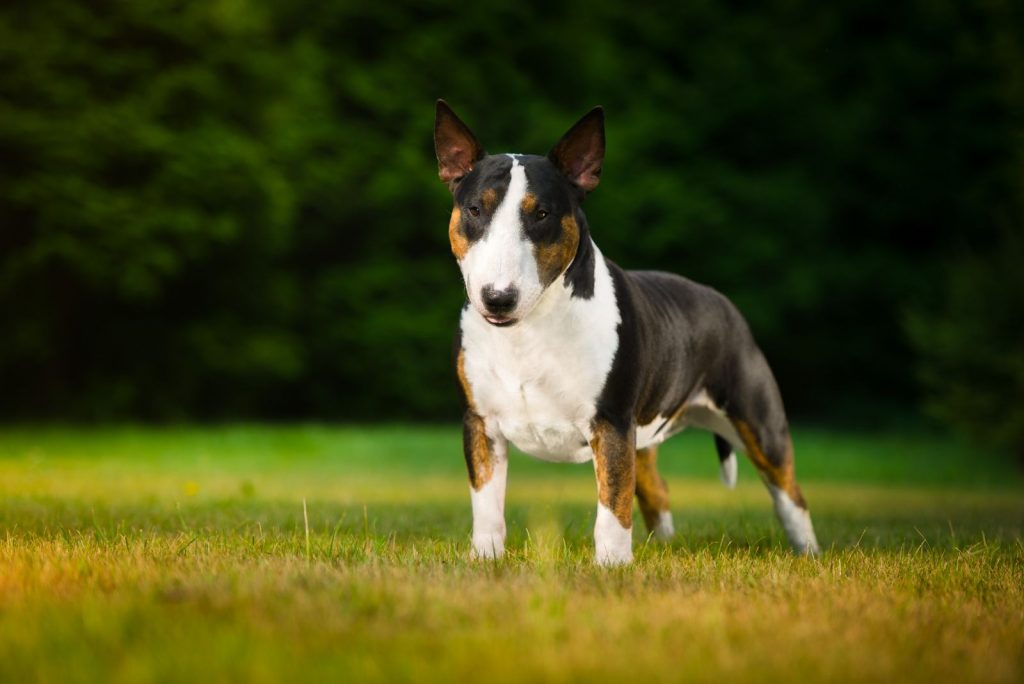

What’s The Average Lifespan Of A Bull Terrier?
Most Bull Terriers tend to have a lifespan of around 11-13 years, slightly less than that of his fellow breeds of the same family, the Staffordshire Bull Terrier who can reach an age of up to 15 years and the Pitbull Terrier who is an in-between with a 14 year peak.
This can be improved with healthy dieting and exercise, and having good genes, of course, but it becomes progressively more difficult given how prone the Bull Terrier can be to kidney disease.
What’s The Best Diet For A Bull Terrier?
While there is no de-facto best diet given the potential allergy risks and other sensitivities a dog may have, there are a few things which are considered better than the others.
The first one is sticking to commercial kibble. Commercial food tends to be better than the wet stuff due to the bits themselves helping clean the dog’s teeth from tartar and plaque and keep them healthy.
On top of all that, it’s usually the cheapest option available as well as the most nutrient dense one without the addition of excess calories.
The other important part is knowing how to portion for your dog.
All portions should be even in quantity and should, preferably, be evenly spaced out time wise so your dog can have healthy energy levels throughout the day.
If you’re interested in the recommended portion sizes themselves, I recommend looking up a feeding chart as a starting reference, and going from there.
Most dry dog food bags will have their own feeding charts which are usually more accurate than the given averages, but you’ll still need to do a bit of fine tuning on your own end to get the right amount for your precious pooch.
Is Wet Food A Recommended Alternative?
Not particularly.
While it is juicier and more flavorful than most dry food options, it’s often the pricier option of the two, especially if you want to match portion sizes.
Not to mention the fact that it stains the teeth real bad and doesn’t help in cleaning them either.
It’s a great option to use as a treat from time to time if your dog has been doing exceptionally well, but not something that should take over the majority of your Bull Terrier’s diet.
If you want to add a wet component to your dog’s meals, consider different forms of gravy, but consider their calorie count in the mix too, so don’t go overboard.
Another good option is bone broth which is both healthy and low calorie.
What About Raw Diets?
That one is up to personal preference.
I personally don’t like them due to the added expenses and the added potential health risks from handling raw meat as well as the time required to prepare the food.
On top of that, you may end up having to rely on supplements as most raw diets leave dogs nutrient deficient in some way.
However, there are some positives, the main one being the sheer customizability of the whole thing.
While I’d still recommend you to stick to kibble, feel free to ask your doctor whether or not a raw diet would benefit your pupper.
What Are Some Common Health Issues In Bull Terriers?
While they are a relatively healthy breed, the Bull Terrier’s genetic makeup leaves them predisposed to some nasty problems at times.
Kidney Disease
The main one at fault would be kidney disease, something that can strike them at any point in their life, but the risk increases as they grow older.
Heart Disease
Another thing worth keeping an eye out in terms of your dog’s health would be heart disease as complications may arise in that area too.
Parasites
Parasites can be a real nightmare too, something your dog may pick up on accident, either from eating undercooked food or by consuming something off the street.
Some of the more common ones are ringworms, hookworms, and tapeworms in particular.
These things are real nasty as they drain the nutrients from the food he consumes once they situate themselves inside his digestive tract and take it for themselves, leaving barely anything for your dog.
This can lead to severe malnutrition and more serious problems if left untreated, particularly in the puppy stage where they need all the nutrients they can get.
If your dog shows any signs of weakness or lethargy, get him to a vet as soon as you can. If parasites are the cause, deworming him should be a priority.
Regardless, make sure you do regular checks for worms during your dog’s puppy period to keep him clean.
Patellar Luxation
Other than that, a luxating patella is something that more commonly happens with them too, and those who are overweight are more prone to it happening, not to mention joint problems on top of that.
Deafness
And finally, a common problem can be deafness which doesn’t really impact his growth, but will impact his daily life, so be sure to give him the best care that he can get in case that ends up befalling him.
Does Spaying Or Neutering My Bull Terrier Cause Complications In His Growth?
Normally it won’t, but only if you do it after he reaches his adult height.
It may sound like a weird connection, but the hormones produced by their reproductive organs affect the function of their growth plates.
If you perform the procedure too early in their lives, it can lead to abnormal growths and added complications which will stick with them throughout their life because the growth plates won’t close up.
So, wait until the 8-9th month or until they’re at least a year old, and even then make sure you confirm it with your dog’s vet to make sure it’s okay for you to go through with the procedure in question.
That’s because some dogs may take a few extra months to reach full maturity.
Should you spay or neuter them? That’s completely up to you, but if they start showing overly aggressive behavior that socialization didn’t manage to fix, then you may need to “fix” them.
How Can I Find Out If My Dog Is Over Or Underweight And What To Do In Order To Fix It?
While there are some clear visual signs of your dog not being the right weight, they usually only show up when the problem starts getting a bit more severe.
In order to more precisely determine this without needing to put him on a scale every time, feel around his ribcage.
If you can’t feel it right away, he may have a few extra pounds on him and you may need to adjust his diet accordingly in order to allow him to drop them back down.
However, if his ribs are clearly sticking out and you can easily feel them, then he may be underfed or nutrient deficient in some areas.
I’d seek advice from your vet if there are other abnormalities alongside either of these two such as lethargy, howls of pain or signs of nausea as there may be an underlying issue on top of what you’re seeing, like parasites.
In Conclusion
A Bull Terrier growth chart can be a useful tool in helping track your dear doggo’s growth throughout his life, showing you what the expected average should be.
However, as with most bits of information, they’re primarily meant to be guidelines that can help you better uncover how best to raise your dog in terms of diet, exercise and general treatment in order to keep him healthy and satisfied throughout his life.
Every dog is unique in his own way and it may take some owners more and others less time to find that ideal method, but I’m confident that you’ll manage with ease.
Just remember that your vet is your most reliable source of information for your dog in particular as he has access to his health records, so if you’re looking for more precise suggestions, I advise seeking advice from him. Until next time, pet parents.
RELATED LINKS:
- 5 Bull Terrier Colors You Need To Know About
- 25 Bull Terrier Mixes You Need To Check Out
- 5 Best Bull Terrier Breeders In The U.S.













